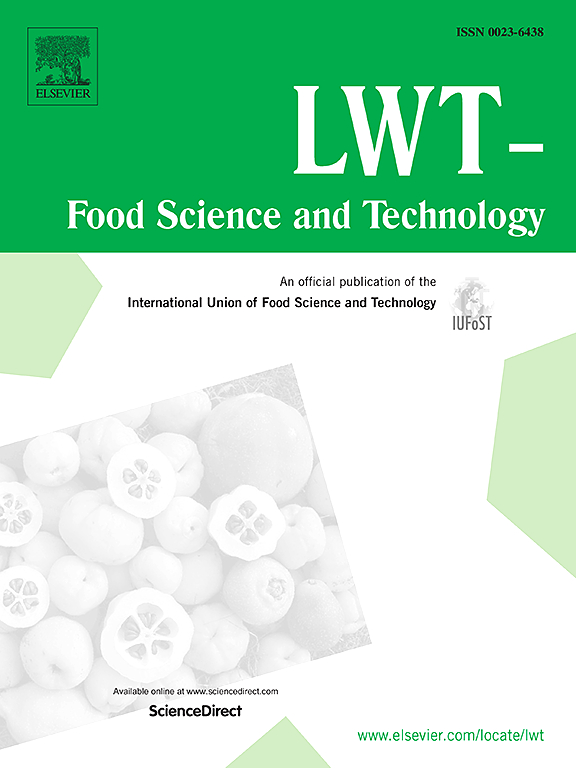Development of prebiotic steamed buns and their influence on gut microbiota and the glycemic index in simulated digestion
IF 6
1区 农林科学
Q1 FOOD SCIENCE & TECHNOLOGY
引用次数: 0
Abstract
This study investigated the effects of adding purple potato anthocyanin (PPA) and Longjing tea powder (LTP) as prebiotics to steamed buns on gut microbiota (GM) and blood glucose levels. The effects of simulated digestion experiments on GM and blood glucose, as well as the results of high-throughput 16S rRNA sequencing, were analyzed. The combined results showed that both kinds of prebiotics significantly promoted the proliferation of Lactobacillus paracasei K56, Lactobacillus plantarum LP-ONLLY, and Lactococcus lactis LC-Plasma. The addition of 50 mg/mL LTP water extract and 2.5 mg/mL PPA water extract had considerable inhibitory effects on Escherichia coli ATCC25922, yielding inhibition zone diameters of 9.16 ± 0.02 and 11.17 ± 0.03 mm, respectively. Both PPA and LTP buns increased the abundance of probiotics in human GM. Prebiotic–xylitol steamed buns could regulate the structure of GM by decreasing the abundance of harmful bacteria (including Shigella and Enterobacter) and increasing the abundance of beneficial bacteria (including Bifidobacterium, Lactobacillus, and Veillonella). Prebiotic steamed buns could significantly reduce the rate of reducing sugar release, the estimated glycemic index (eGI), and the estimated glycemic load (eGL), providing products with a medium glycemic index and potential natural prebiotics as resources for the development of functional staple foods.
益生菌馒头的开发及其对肠道微生物群和模拟消化升糖指数的影响
本研究探讨了在馒头中添加紫薯花青素(PPA)和龙井茶粉(LTP)作为益生元对肠道微生物群(GM)和血糖水平的影响。实验分析了模拟消化实验对 GM 和血糖的影响,以及高通量 16S rRNA 测序的结果。综合结果显示,两种益生元都能显著促进副乳杆菌K56、植物乳杆菌LP-ONLLY和乳酸乳球菌LC-Plasma的增殖。添加 50 毫克/毫升 LTP 水提取物和 2.5 毫克/毫升 PPA 水提取物对大肠杆菌 ATCC25922 有相当大的抑制作用,抑制区直径分别为 9.16 ± 0.02 毫米和 11.17 ± 0.03 毫米。PPA 和 LTP 面包都增加了人体转基因中益生元的含量。益生元木糖醇馒头可通过减少有害菌(包括志贺氏菌和肠杆菌)的数量和增加有益菌(包括双歧杆菌、乳酸杆菌和维氏菌)的数量来调节转基因的结构。益生元馒头可显著降低还原糖释放率、估计血糖生成指数(eGI)和估计血糖生成负荷(eGL),为开发功能性主食提供了中等血糖生成指数的产品和潜在的天然益生元资源。
本文章由计算机程序翻译,如有差异,请以英文原文为准。
求助全文
约1分钟内获得全文
求助全文
来源期刊

LWT - Food Science and Technology
工程技术-食品科技
CiteScore
11.80
自引率
6.70%
发文量
1724
审稿时长
65 days
期刊介绍:
LWT - Food Science and Technology is an international journal that publishes innovative papers in the fields of food chemistry, biochemistry, microbiology, technology and nutrition. The work described should be innovative either in the approach or in the methods used. The significance of the results either for the science community or for the food industry must also be specified. Contributions written in English are welcomed in the form of review articles, short reviews, research papers, and research notes. Papers featuring animal trials and cell cultures are outside the scope of the journal and will not be considered for publication.
 求助内容:
求助内容: 应助结果提醒方式:
应助结果提醒方式:


